O. Kh. Khalpakhchian – Architectural ensembles of Armenia
Photos: A. Alexandrov, A. and V. Kochar, from stocks of the History Museum of the Academy of Sciences of the Armenian SSR
Dvin is situated on a hill where a settlement, turned into a fortress in the antique epoch, had existed since the third millenium B.C. In the reign of Khosrov II (330-338) Dvin became the capital, and since the middle of the fifth century till the middle of the 13th century it was a major trade, handicraft and cultural centre of Armenia known in the countries of Asia Minor and Europe.
 Excavations revealed the layout of Dvin which followed the pattern of Armenia's ancient fortified settlements. Double town walls were fortified with large round towers, and the citadel had a moat around it.
Excavations revealed the layout of Dvin which followed the pattern of Armenia's ancient fortified settlements. Double town walls were fortified with large round towers, and the citadel had a moat around it.
The ruler's palace was situated on the top of a high hill which dominated the town, inside a vast citadel. The rectangular-base building was a two-storey one, with richly decorated presence and residence chambers in the first floor, and service premises, including a bath-house with men's and women's sections equipped like that in Garni, in the ground floor. This palace, just as the palaces of feudal lords (nakharars) and the suburban palace of King Khosrov II in the valley of the Azat river, which gave Armenian historians the grounds for calling Dvin "tremendous", "famous", "the well-known great capital of great Armenians", was no doubt among the best civil buildings of the fifth-century Armenia.
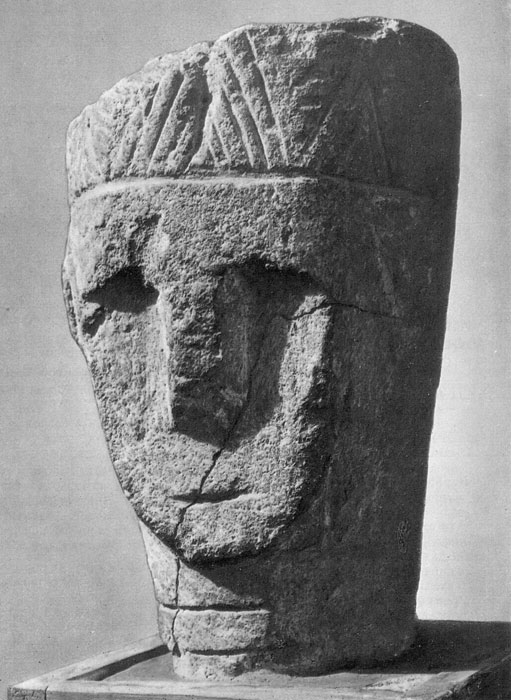 The palace of Katholikos - the head of the Armenian clergy - was in the central neighbourhood to the west of the citadel, among the monumental stone structures of the city which formed one of the prominent architectural ensembles of Armenia of those times.
The palace of Katholikos - the head of the Armenian clergy - was in the central neighbourhood to the west of the citadel, among the monumental stone structures of the city which formed one of the prominent architectural ensembles of Armenia of those times.
The ruins of Katholikos' palace - an imposing edifice built in the 7th century - are very impressive. The front part, built under the influence of the architecture of the Armenian peasant home, had as its nucleus the central hall (11.4 by 26.7 m) with two rows of columns, with rectangular rooms adjacent to its lateral sides. Our reconstruction shows that the hall was roofed with three octahedral wooden marquees with opening in their tops to let in light. Stone columns with the base shape of the antique type were crowned with eye-catching volute-like capitals. Their face side is adorned with coiled palm leaves, with two others rising from between them, as if from the column shaft. The abacus is decorated with a carved ornament.
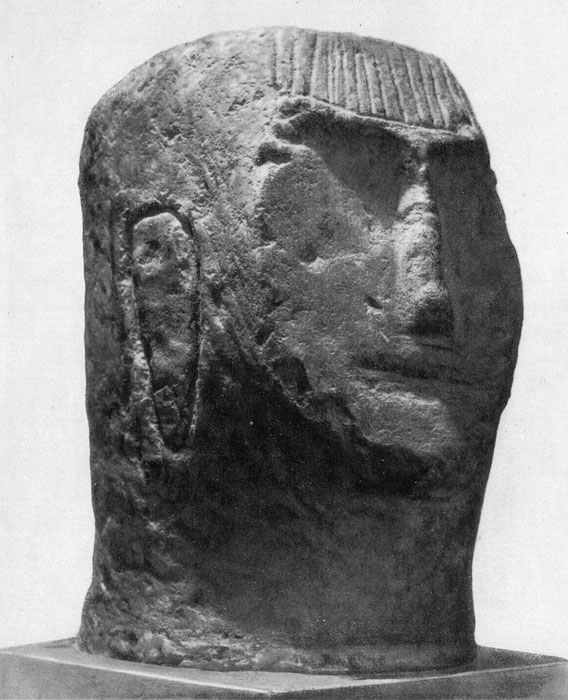 The architecture of Katholikos' palace in Dvin played a great role in the development of civil architecture in Armenia in early feudal times. Its influence showed, for instance, in the composition and decoration of Grigory Mamikony-an's palace in Arucha, built in the 680s, and partially in the palace of Nerses III in Zvartnots (the middle of the 7th century).
The architecture of Katholikos' palace in Dvin played a great role in the development of civil architecture in Armenia in early feudal times. Its influence showed, for instance, in the composition and decoration of Grigory Mamikony-an's palace in Arucha, built in the 680s, and partially in the palace of Nerses III in Zvartnots (the middle of the 7th century).
A small vaulted church of 553-554 was situated east of the Katholikos' palace in Dvin. The annex and a five-arc gallery on the northern side make it possible to date it back to the fourth-seventh centuries when the temples of this type were built in Armenia.
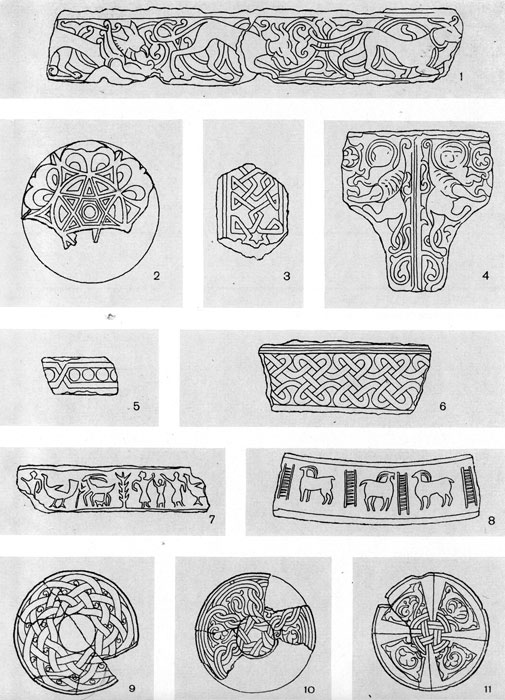 St. Grigory Cathedral was more monumental and Armenia's biggest one (30.41 by 58.17 m). Built in the third century as a three-nave heathen temple with seven pairs of inner supports, it was re-built in the fourth century into a Christian church, with a pentahedral altar apse protruding sharply on its eastern side. In the middle of the fifth century an outside arched gallery was added to it. In the middle of the seventh century the cathedral was rebuilt into a cross-winged domed temple with apses protruding on the lateral facades.
St. Grigory Cathedral was more monumental and Armenia's biggest one (30.41 by 58.17 m). Built in the third century as a three-nave heathen temple with seven pairs of inner supports, it was re-built in the fourth century into a Christian church, with a pentahedral altar apse protruding sharply on its eastern side. In the middle of the fifth century an outside arched gallery was added to it. In the middle of the seventh century the cathedral was rebuilt into a cross-winged domed temple with apses protruding on the lateral facades.
The history of the construction and reconstruction of the cathedral in Dvin is a vivid example of the evolution of artistic views over the period since the fourth century to its destruction in 893. The layout of the fifth-century building was reproduced in Odzun temple of the 6th century in Odzoon (Uzunlar) and in Talin cathedral in the middle of the 7th century.
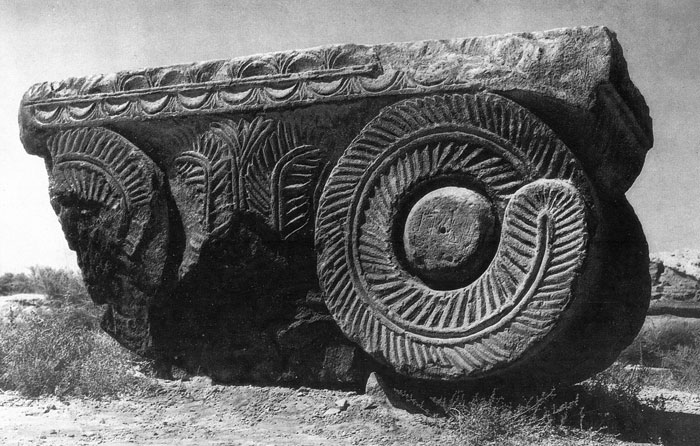 The cathedral was richly decorated. The mosaic floor composed of vari-coloured soft-toned stone slabs had a geometrical pattern, and pylon capitals were of an intricate shape made up of horizontal and vertical lines, and the cornices were shaped as a contexture of three interlaced strands. The altar apse was decorated with a mosaic of vari-coloured cubes of smalt and tufa representing the Holy Virgin (the 7th century). That was the most ancient mosaic depiction of the Holy Virgin on the territory of Armenia.
The cathedral was richly decorated. The mosaic floor composed of vari-coloured soft-toned stone slabs had a geometrical pattern, and pylon capitals were of an intricate shape made up of horizontal and vertical lines, and the cornices were shaped as a contexture of three interlaced strands. The altar apse was decorated with a mosaic of vari-coloured cubes of smalt and tufa representing the Holy Virgin (the 7th century). That was the most ancient mosaic depiction of the Holy Virgin on the territory of Armenia.
Excavations revealed that the town of Dvin had a very close layout. Unfortunately, only some odd fragments of its numerous buildings have survived, but these fragments can give us an idea of the artistic standards of architecture of various periods.
A fragment of the capital of a single column - a part of a memorial found in the central neighbourhood and dating back to an early period of Dvin's history - is now on display in the State History Museum of Armenia in Yerevan. Such memorials were quite common in Armenia in the fifth-seventh centuries. The front part of the capital is adorned with a cross the upper arm of which is replaced by a symbolic representation of Christ; to the right, there is a figure of a saint, presumably John the Baptist. In the side, there is also a figure of a saint, probably St. George, on a horse trampling with its hoof on a serpent with open jaws. Only the front part of the horse and the rider's right hand, holding the rein, have survived.
The composition of the front side of the capital is a unique phenomenon in Armenian decorative art. Iconographic analogies of the columns' bas-relief are to be found in the early Christian art of Armenia and Middle Asia, specifically in Palestine. In Palestine such compositions were made on lead and silver ampules of the early seventh century, now in the collections of Monza and Bobbio, Northern Italy.
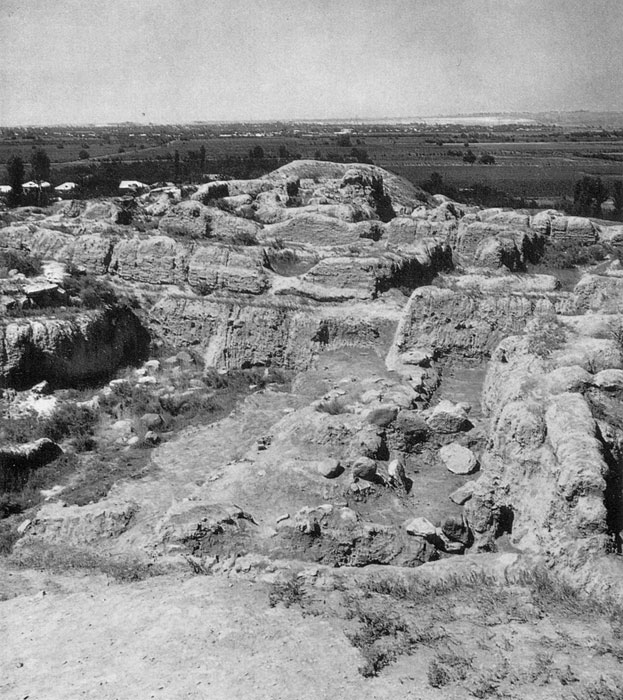 Of interest is a bas-relief on a large stone showing a grape harvesting scene. The stone served as a lintel of a broad doorway of a monumental secular building of the fifth-sixth centuries. There survived the left half of the stone with a part of the cross the lower arm of which seems to grow out of sprouting shoots. On this part of the bas-relief we can see the figures of two women picking grapes and bearing a basketful of grape bunches on their shoulders. The dynamic figures of the women, the grape bunches and the stylized leaves are conveyed realistically and in perspective. A peacock, vividly depicted on white limestone, is dated to the 6th century by analogy with a similar relief on Ptgni temple.
Of interest is a bas-relief on a large stone showing a grape harvesting scene. The stone served as a lintel of a broad doorway of a monumental secular building of the fifth-sixth centuries. There survived the left half of the stone with a part of the cross the lower arm of which seems to grow out of sprouting shoots. On this part of the bas-relief we can see the figures of two women picking grapes and bearing a basketful of grape bunches on their shoulders. The dynamic figures of the women, the grape bunches and the stylized leaves are conveyed realistically and in perspective. A peacock, vividly depicted on white limestone, is dated to the 6th century by analogy with a similar relief on Ptgni temple.
Gypsum decorations, which cost much less than stone ones, became widely spread in the ornamentation of Dvin's buildings since the 9th century. Various geometrical and pictorial elements of decoration - such as the figures of running animals against the background of a floral ornament - were cast and cut out of gypsum. These decorations appear on wall niches, interior doorways and window fillings. Carved on gypsum were figures of fantastic animals, such as sirins - winged lions with human heads crowned with three-tooth coronets. These pictures are characteristic of many architectural monuments and miniatures of Armenia of the 13th century. A distinguishing feature of a gypsum platband of a niche in one of the rooms of the citadel's residential block is that it is templet cast, as indicated by the flaws recurring in other castings. Similar cast gypsum plates in Ani show that templets were widely used in Armenia in the 12th-13th centuries.
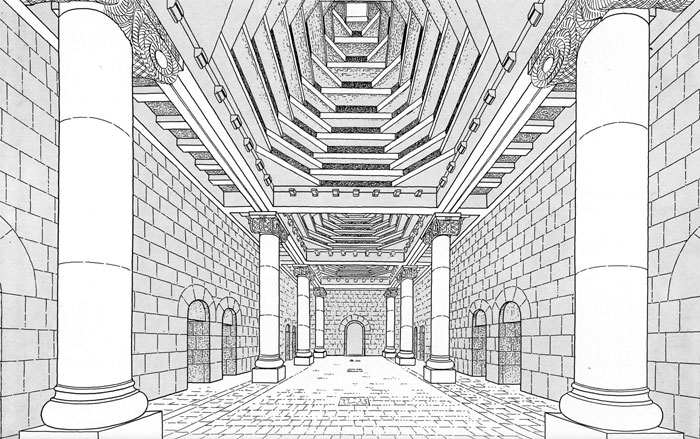 Standard elements were also used in decorating utensils, such as clay jugs for various purposes and crockery. Faience earthenware ornamented with women's and lions' heads and patterns in relief and glazed dark or light blue are most unusual. On the jar girdles there appear stamped ornaments showing human figures, plants and animals. Multi-coloured glazed cups were also adorned with such as well as "architectural" ornaments.
Standard elements were also used in decorating utensils, such as clay jugs for various purposes and crockery. Faience earthenware ornamented with women's and lions' heads and patterns in relief and glazed dark or light blue are most unusual. On the jar girdles there appear stamped ornaments showing human figures, plants and animals. Multi-coloured glazed cups were also adorned with such as well as "architectural" ornaments.
On the territory of Dvin archaeologists found several sculptures of men's heads of reddish tufa, probably knocked off life-size statues. Judging by the rough hewing of the backs of the heads, the statues had been placed in niches or at walls and intended for frontside viewing. Analysing the headgear and adornments and comparing them with the portraits of Artashesid kings on coins, K. G. Kafadarian arrived at the conclusion that the statues represented secular rulers of Armenia.
The archaic manner in which the heads are cut makes it possible to date them back to the 3rd-2nd cc. B.C. These works of art of local origin mark an important stage in the history of ancient Armenia's sculpture of the antique period.
Photos: A. Alexandrov, A. and V. Kochar, from stocks of the History Museum of the Academy of Sciences of the Armenian SSR
Dvin is situated on a hill where a settlement, turned into a fortress in the antique epoch, had existed since the third millenium B.C. In the reign of Khosrov II (330-338) Dvin became the capital, and since the middle of the fifth century till the middle of the 13th century it was a major trade, handicraft and cultural centre of Armenia known in the countries of Asia Minor and Europe.
 Excavations revealed the layout of Dvin which followed the pattern of Armenia's ancient fortified settlements. Double town walls were fortified with large round towers, and the citadel had a moat around it.
Excavations revealed the layout of Dvin which followed the pattern of Armenia's ancient fortified settlements. Double town walls were fortified with large round towers, and the citadel had a moat around it.The ruler's palace was situated on the top of a high hill which dominated the town, inside a vast citadel. The rectangular-base building was a two-storey one, with richly decorated presence and residence chambers in the first floor, and service premises, including a bath-house with men's and women's sections equipped like that in Garni, in the ground floor. This palace, just as the palaces of feudal lords (nakharars) and the suburban palace of King Khosrov II in the valley of the Azat river, which gave Armenian historians the grounds for calling Dvin "tremendous", "famous", "the well-known great capital of great Armenians", was no doubt among the best civil buildings of the fifth-century Armenia.
 The palace of Katholikos - the head of the Armenian clergy - was in the central neighbourhood to the west of the citadel, among the monumental stone structures of the city which formed one of the prominent architectural ensembles of Armenia of those times.
The palace of Katholikos - the head of the Armenian clergy - was in the central neighbourhood to the west of the citadel, among the monumental stone structures of the city which formed one of the prominent architectural ensembles of Armenia of those times.The ruins of Katholikos' palace - an imposing edifice built in the 7th century - are very impressive. The front part, built under the influence of the architecture of the Armenian peasant home, had as its nucleus the central hall (11.4 by 26.7 m) with two rows of columns, with rectangular rooms adjacent to its lateral sides. Our reconstruction shows that the hall was roofed with three octahedral wooden marquees with opening in their tops to let in light. Stone columns with the base shape of the antique type were crowned with eye-catching volute-like capitals. Their face side is adorned with coiled palm leaves, with two others rising from between them, as if from the column shaft. The abacus is decorated with a carved ornament.
 The architecture of Katholikos' palace in Dvin played a great role in the development of civil architecture in Armenia in early feudal times. Its influence showed, for instance, in the composition and decoration of Grigory Mamikony-an's palace in Arucha, built in the 680s, and partially in the palace of Nerses III in Zvartnots (the middle of the 7th century).
The architecture of Katholikos' palace in Dvin played a great role in the development of civil architecture in Armenia in early feudal times. Its influence showed, for instance, in the composition and decoration of Grigory Mamikony-an's palace in Arucha, built in the 680s, and partially in the palace of Nerses III in Zvartnots (the middle of the 7th century).A small vaulted church of 553-554 was situated east of the Katholikos' palace in Dvin. The annex and a five-arc gallery on the northern side make it possible to date it back to the fourth-seventh centuries when the temples of this type were built in Armenia.
 St. Grigory Cathedral was more monumental and Armenia's biggest one (30.41 by 58.17 m). Built in the third century as a three-nave heathen temple with seven pairs of inner supports, it was re-built in the fourth century into a Christian church, with a pentahedral altar apse protruding sharply on its eastern side. In the middle of the fifth century an outside arched gallery was added to it. In the middle of the seventh century the cathedral was rebuilt into a cross-winged domed temple with apses protruding on the lateral facades.
St. Grigory Cathedral was more monumental and Armenia's biggest one (30.41 by 58.17 m). Built in the third century as a three-nave heathen temple with seven pairs of inner supports, it was re-built in the fourth century into a Christian church, with a pentahedral altar apse protruding sharply on its eastern side. In the middle of the fifth century an outside arched gallery was added to it. In the middle of the seventh century the cathedral was rebuilt into a cross-winged domed temple with apses protruding on the lateral facades.The history of the construction and reconstruction of the cathedral in Dvin is a vivid example of the evolution of artistic views over the period since the fourth century to its destruction in 893. The layout of the fifth-century building was reproduced in Odzun temple of the 6th century in Odzoon (Uzunlar) and in Talin cathedral in the middle of the 7th century.
 The cathedral was richly decorated. The mosaic floor composed of vari-coloured soft-toned stone slabs had a geometrical pattern, and pylon capitals were of an intricate shape made up of horizontal and vertical lines, and the cornices were shaped as a contexture of three interlaced strands. The altar apse was decorated with a mosaic of vari-coloured cubes of smalt and tufa representing the Holy Virgin (the 7th century). That was the most ancient mosaic depiction of the Holy Virgin on the territory of Armenia.
The cathedral was richly decorated. The mosaic floor composed of vari-coloured soft-toned stone slabs had a geometrical pattern, and pylon capitals were of an intricate shape made up of horizontal and vertical lines, and the cornices were shaped as a contexture of three interlaced strands. The altar apse was decorated with a mosaic of vari-coloured cubes of smalt and tufa representing the Holy Virgin (the 7th century). That was the most ancient mosaic depiction of the Holy Virgin on the territory of Armenia.Excavations revealed that the town of Dvin had a very close layout. Unfortunately, only some odd fragments of its numerous buildings have survived, but these fragments can give us an idea of the artistic standards of architecture of various periods.
A fragment of the capital of a single column - a part of a memorial found in the central neighbourhood and dating back to an early period of Dvin's history - is now on display in the State History Museum of Armenia in Yerevan. Such memorials were quite common in Armenia in the fifth-seventh centuries. The front part of the capital is adorned with a cross the upper arm of which is replaced by a symbolic representation of Christ; to the right, there is a figure of a saint, presumably John the Baptist. In the side, there is also a figure of a saint, probably St. George, on a horse trampling with its hoof on a serpent with open jaws. Only the front part of the horse and the rider's right hand, holding the rein, have survived.
The composition of the front side of the capital is a unique phenomenon in Armenian decorative art. Iconographic analogies of the columns' bas-relief are to be found in the early Christian art of Armenia and Middle Asia, specifically in Palestine. In Palestine such compositions were made on lead and silver ampules of the early seventh century, now in the collections of Monza and Bobbio, Northern Italy.
 Of interest is a bas-relief on a large stone showing a grape harvesting scene. The stone served as a lintel of a broad doorway of a monumental secular building of the fifth-sixth centuries. There survived the left half of the stone with a part of the cross the lower arm of which seems to grow out of sprouting shoots. On this part of the bas-relief we can see the figures of two women picking grapes and bearing a basketful of grape bunches on their shoulders. The dynamic figures of the women, the grape bunches and the stylized leaves are conveyed realistically and in perspective. A peacock, vividly depicted on white limestone, is dated to the 6th century by analogy with a similar relief on Ptgni temple.
Of interest is a bas-relief on a large stone showing a grape harvesting scene. The stone served as a lintel of a broad doorway of a monumental secular building of the fifth-sixth centuries. There survived the left half of the stone with a part of the cross the lower arm of which seems to grow out of sprouting shoots. On this part of the bas-relief we can see the figures of two women picking grapes and bearing a basketful of grape bunches on their shoulders. The dynamic figures of the women, the grape bunches and the stylized leaves are conveyed realistically and in perspective. A peacock, vividly depicted on white limestone, is dated to the 6th century by analogy with a similar relief on Ptgni temple.Gypsum decorations, which cost much less than stone ones, became widely spread in the ornamentation of Dvin's buildings since the 9th century. Various geometrical and pictorial elements of decoration - such as the figures of running animals against the background of a floral ornament - were cast and cut out of gypsum. These decorations appear on wall niches, interior doorways and window fillings. Carved on gypsum were figures of fantastic animals, such as sirins - winged lions with human heads crowned with three-tooth coronets. These pictures are characteristic of many architectural monuments and miniatures of Armenia of the 13th century. A distinguishing feature of a gypsum platband of a niche in one of the rooms of the citadel's residential block is that it is templet cast, as indicated by the flaws recurring in other castings. Similar cast gypsum plates in Ani show that templets were widely used in Armenia in the 12th-13th centuries.
 Standard elements were also used in decorating utensils, such as clay jugs for various purposes and crockery. Faience earthenware ornamented with women's and lions' heads and patterns in relief and glazed dark or light blue are most unusual. On the jar girdles there appear stamped ornaments showing human figures, plants and animals. Multi-coloured glazed cups were also adorned with such as well as "architectural" ornaments.
Standard elements were also used in decorating utensils, such as clay jugs for various purposes and crockery. Faience earthenware ornamented with women's and lions' heads and patterns in relief and glazed dark or light blue are most unusual. On the jar girdles there appear stamped ornaments showing human figures, plants and animals. Multi-coloured glazed cups were also adorned with such as well as "architectural" ornaments.On the territory of Dvin archaeologists found several sculptures of men's heads of reddish tufa, probably knocked off life-size statues. Judging by the rough hewing of the backs of the heads, the statues had been placed in niches or at walls and intended for frontside viewing. Analysing the headgear and adornments and comparing them with the portraits of Artashesid kings on coins, K. G. Kafadarian arrived at the conclusion that the statues represented secular rulers of Armenia.
The archaic manner in which the heads are cut makes it possible to date them back to the 3rd-2nd cc. B.C. These works of art of local origin mark an important stage in the history of ancient Armenia's sculpture of the antique period.
Комментариев нет:
Отправить комментарий